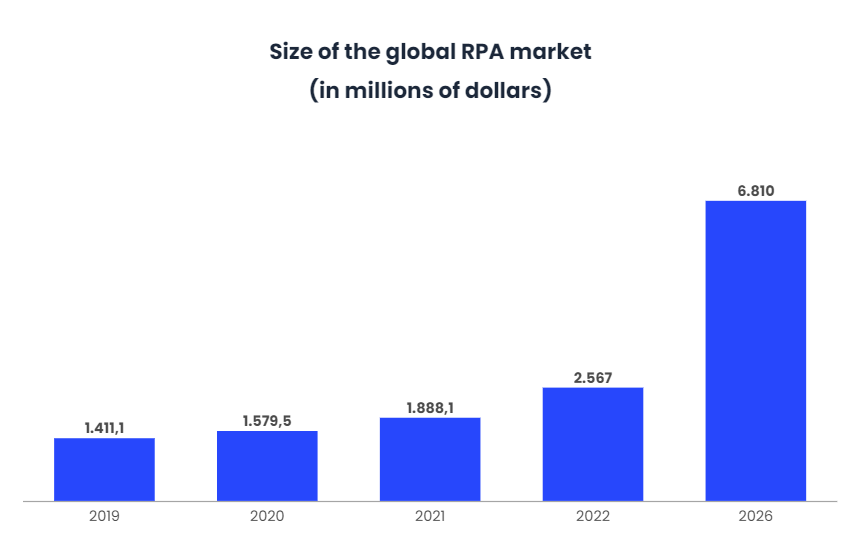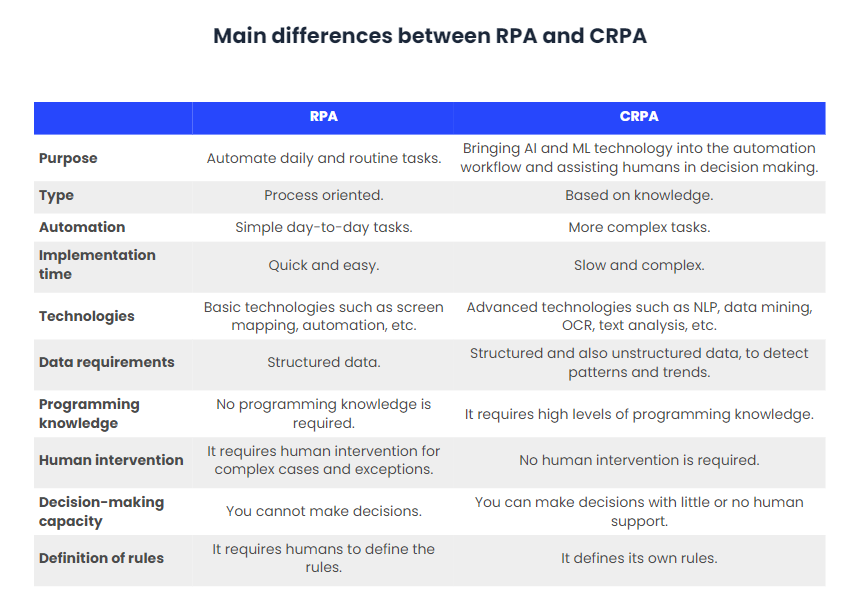Cognitive RPA takes intelligence to another level

In recent years, Robotic Process Automation (RPA) has been a viable and cost-effective tool that has helped companies to continue to grow, reduce costs and improve the customer experience.
The advantage of minimal investment, faster ROI and relatively easy implementation has led to an increasing number of companies in all industry sectors implementing and testing the capabilities offered by RPA technology. In fact, it is estimated that by 2026 the global market will reach $6.81 billion.

However, today’s digital world is beginning to demand more than just automation processes. Automated tools are now being asked to not only complete tasks at a rapid pace, but to do so with greater efficiency and productivity, and as the complexity of processes grows, the workforce is demanding a smarter assistant who can also bring intelligence.
RPA’s technology performs tasks with precision and agility, making it perfect for repetitive activities and back-end processes. It has proven to support significant production in a shorter response time than a single person, but it is still a technology that simply repeats the same tasks over and over again. With advances in Artificial Intelligence (AI) and Machine-learning (ML), RPA tools are becoming more intelligent and deriving into cognitive RPA platforms.
The arrival of Cognitive RPA
Cognitive RPA (CRPA) takes advantage of Artificial Intelligence technologies such as Optical Character Recognition (OCR), Natural Language Processing (NLP), text analysis, data mining or Machine-learning to understand the deeper complexities of a process, improve and adapt to constantly changing needs and when necessary, enhance the experience of both the workforce and customers.
The ML allows CRPA tools to adapt to new situations, for example, if the user interface of a payroll system changes, the tool can recognise those changes and achieve the same result.
The NLP technology, on the other hand, allows the CRPA software to read, understand and generate text, for example, it can detect if the customer’s name appears, on a new invoice, in a different section compared to previous invoices, and use the tool to extract relevant information to generate reports, invoices and other documents.
Therefore, the processes that this technology can perform include learning (acquiring a lot of information to learn everything necessary from it), reasoning (using that information to make decisions) and self-correction (learning from successes and failures). Because of this it imitates human intelligence and actions and automates tasks that do not follow a fixed and established set of rules. In fact, it has the ability to build its own rules, find patterns and build relationships between different data sources, both structured and unstructured, while helping humans make intelligent business decisions. Unstructured data sources can include scanned documents, emails, letters or voice recordings.
Cognitive RPA enables companies to automate much more complex tasks, more accurately and quickly, and drive analytically based decisions. This is why companies are starting to use CRPA to meet their growing demands. In fact, the global CRPA market is expected to reach $150 billion by the end of 2027.

Main benefits and challenges of CRPA
CRPA improves the efficiency and quality of computer-generated responses, but in addition to this, this technology offers companies a number of benefits, among which are
- It is a cost-effective technology, as it can help companies save up to 50% of their total expenditure.
- It improves employee productivity, which leads to better operational efficiency.
- It is designed to mimic the way humans think to support much more complex tasks and understand more complex processes.
- It can be used to improve data, since, with the use of Natural Language Processing technology and text analysis it can transform unstructured data into structured data.
- It is a technology that offers great precision in the results.
- CRPA together with predictive analysis technology can improve the automation of decision making, as the system learns and expands the capabilities to continuously improve certain aspects of its functionality on its own.
- It reduces and even eliminates human intervention.
- You can achieve better business results, increased revenue and improved customer satisfaction.
- By using complex and advanced technologies, the CRPA can make more intuitive judgments and perceptions about how humans speak, write and interact, as well as define rules to determine the optimal solution for all situations presented to it.
However, despite the many benefits, CRPA technology also has some challenges, and understanding and overcoming these will be key to the success of projects.
- One of these challenges may be the resistance of employees to training and using this technology, mainly because of the fear of losing their jobs.
- As this technology is practically new, the tools may still have some limitations.
- The time and cost of implementation are considerably higher than for other technologies.
- In addition, it requires high levels of programming knowledge to be able to implement it.
Cases of use of the CRPA
As you can see, despite the possible challenges, the advantages of CRPA are virtually unlimited, and that is why it is being applied in various industries where this technology is quite useful. Let’s look at some examples:
Finance and banking
In banking, it is imperative to have an ordered set of information and data so that an analysis can be made of customers who, for example, urgently need a loan or other banking services. However, as the amount of data generated in the sector is enormous and often received from multiple sources, manual segregation of such data becomes repetitive and time-consuming.
By integrating KYC (Know Your Customer) requirements with CRPA technology, tasks can be accelerated. CRPA can evaluate public records, scan documents and process both local and international transactions, reduce paperwork, help obtain valuable customer information and assist in making intelligent customer decisions.
This technology can also be used to communicate with customers and address their needs. An example is combining CRPA with AI for chatbots that can make a customer feel as if they are interacting with a human customer service representative, and also automate most of the process, for example, opening a new bank account. Another example is creating voice bots for telephone conversations.
Insurance
In the insurance industry, Cognitive RPA has multiple areas of application. On the one hand, claims settlement is a major challenge, as it involves reviewing policy documents, coverage, validity of insured components, fraud analysis and more. RPA Cognitiva’s technology allows automated decisions to be made, in a matter of seconds, by analysing all the parameters of the claims in real time.
This technology together with the ML and NLP can also be used to help automate the process of reviewing a client’s application for a new policy. The CRPA can learn, from previous applications, how to make the decision on whether to accept or reject a new policy application, and can do so automatically.
This allows insurers to respond more quickly to customers and save a lot of time and money, as well as to reallocate resources to activities that generate more revenue or to continue innovating in products that benefit long-term growth, and the acquisition of new customers.
Retail
One of the big challenges in the retail sector is to harmonise the data that comes to them from the different shops and departments. The CRPA is helping retailers to improve their data collection process so that they can build strong business plans by reducing considerable time spent on writing and compiling reports. CRPA also forecasts sales figures, monitors inventory levels, tracks logistics, generates customer profiles and deciphers changing customer buying preferences.
With the help of AI and CRPA tools, valuable information can be extracted from the data collected on product suppliers, partners and retailers, ensuring that the efficiency and accuracy of operations are not frustrated.
On the other hand, one of the most interesting ways to implement these applications and technologies is through omnicron communications. Currently, customers interact with a brand through different points of contact and channels: chat, social networks, applications, messaging and more. When CRPA is integrated with these channels, chatbots, for example, can decipher a customer’s request and offer the best possible solution by understanding the feelings and needs of that customer.
Conclusions
Cognitive RPA can go further to achieve better business outcomes such as higher revenues and customer satisfaction, and lower dropout rates. It is a technology that is able to understand more complex tasks, adapt to dynamic situations and predict outcomes based on unstructured data.
Companies that adopt CRPA can achieve cost efficiencies at scale, be more responsive to customers and ultimately reallocate employees to higher value activities. This technology shows clear potential to reshape the automation landscape, and companies should consider investing in CRPA, as it matures, to help scale their operations.
However, while CRPA brings immense benefits, there is also a challenge in its successful adoption and implementation. This is where testing assumes a key role, as technology expands its dominance over all industries, including banking, manufacturing, retail, healthcare, insurance or telecommunications, careful testing of CRPA is required for successful implementation and final adoption.
CRPA technology can generate great value, but only when it is effectively implemented.


